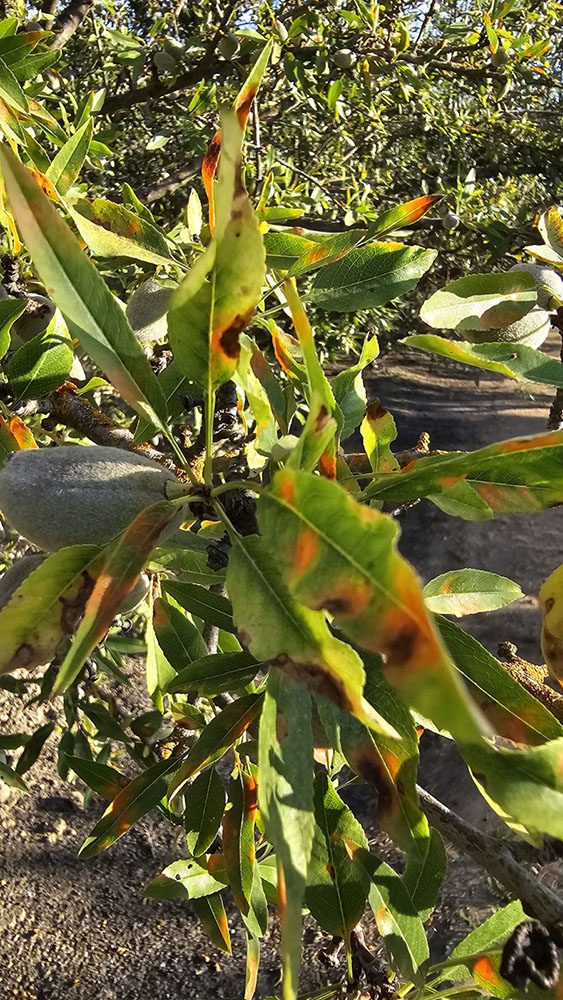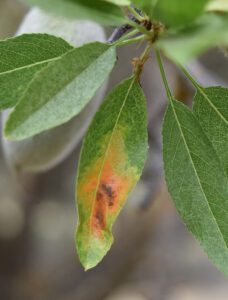
Almond growers can add another fungal disease to be on the lookout for next spring. Red leaf blotch (RLB), caused by the pathogen Polystigma amygdalinum, was detected in at least four northern San Joaquin Valley counties this spring.
CDFA, USDA and the Trouillas Lab at UC Davis have confirmed the outbreak was caused by this specific pathogen, which is one of the most important leaf diseases currently affecting almond production in Spain, Portugal and the Middle East. This is the first detection of this pathogen in California.
Florent Trouillas, a UCCE fruit and nut crop pathology specialist at Kearney Agriculture Research and Education Center and UC Davis, said it was likely the pathogen was introduced to California in plant material. He said this year’s outbreak is related to a recent introduction of the pathogen in almond orchards.
RLB causes trees to prematurely defoliate. In the early stages, symptoms of the infection are small, yellowish spots or blotches on both sides of the leaves. Blotches grow in size as the disease progresses, and they will change color from yellow to yellowish-orange with a reddish-brown center. In advanced stages of infection, leaves become necrotic, curl and drop prematurely. Trouillas reported in a UC newsletter the disease may not be noticed in orchards before late April to mid-May as the infection remains latent for 35 to 40 days after infection. Growers and PCAs should be on the lookout for RLB at that time and understand the inoculum is present in the orchard and can affect subsequent crops.
RLB has only one primary infection cycle. The inoculum comes from sexual fruiting bodies on fallen infected leaves from the previous growing season. The infection strikes after petal fall when young leaves begin to emerge. Rain at this time spreads the fungal spores. During spring and summer, leaves contain the pathogen, but the spores do not cause new infection on the leaves. Infections drop with high summer temperatures. The inoculum goes dormant until dispersed by rain at bloom time.
Trouillas said orchards that were infected this year are likely to have repeat infections in 2025 due to the inoculum in the orchard on the fallen leaves.
Premature defoliation affects photosynthesis which can affect the current crop, depending on the level of infection. A bigger concern is the effect the disease can have on the next year’s crop due to reduction of carbohydrate reserves in the tree.
Like many other fungal diseases, rain is necessary for the release and dispersal of the fungal spores.
‘There is definitely a relationship between last spring’s wet weather and the spread of this disease,” Trouillas said. Last year’s wet spring provided an opportunity for the disease to spread. It has been observed in orchards in Fresno, Madera, Merced, San Joaquin and Stanislaus counties. RLB symptoms were first noticed in Nonpareil, Monterey and Fritz almond varieties, but Trouillas said it is likely to be widespread in other cultivars.
In addition to the wet spring sparking the RLB outbreak, Trouillas said growers may have skipped critical fungicide sprays, missing an opportunity to prevent the disease outbreak. By the time symptoms are noticeable and diagnosed, it is too late for treatment.

Effective RLB control
Effective control of RLB is similar to other fungal bloom diseases like shot hole or anthracnose, but timing may vary. In Spain, growers are using one preventative fungicide application at petal fall followed by two more at two and five weeks after petal fall if rain persists.
Fungicides from FRAC groups 7, 11, M3, M4 and some FRAC 3 chemistries are most effective. Cultural practices, such as removing leaf litter or applying urea to accelerate its decomposition, are crucial but effective only when widely applied.
Almond Board is asking growers who suspect RLB in their orchard to avoid collecting leaf samples and transporting them to reduce the potential spread of the pathogen to uninfected areas. Growers who suspect the disease in their orchards are urged to contact their local UCCE farm advisor. Early detection and management are vital to protecting California’s almond industry from this new threat.
Orchard Visits
Cameron Zuber, orchard crops advisor in Merced County, said he was first contacted by a consultant about unusual lesions on tree leaves in early June. By that time lesions were large with some having a slightly darker center. RLB was diagnosed by the Trouillas lab and confirmed by CDFA. Zuber said 1% to 5% percent of leaves had visible lesions at that visit.
Other orchards Zuber visited later had similar severity, and some were worse. He noted other UC advisors had also been told of orchards with disease symptoms in other northern San Joaquin Valley counties. The level of disease varied from orchard to orchard, he said.
“With some, you had to look closely, others you could just drive by the orchard and see a high rate of infection,” Zuber said. Lesions on affected trees are found throughout the canopy.
Current understanding with RLB says there is one infection period, and those leaves affected at that time could shed when they become necrotic later in the season.
Zuber said some growers and consultants have been trying to reduce pesticide application during bloom and post-bloom, and though they typically do make fungicide applications for other diseases, he said timing for sprays to prevent RLB may be different.

Cecilia Parsons | Associate Editor
Cecilia Parsons has lived in the Central Valley community of Ducor since 1976, covering agriculture for numerous agricultural publications over the years. She has found and nurtured many wonderful and helpful contacts in the ag community, including the UCCE advisors, allowing for news coverage that focuses on the basics of food production.
She is always on the search for new ag topics that can help growers and processors in the San Joaquin Valley improve their bottom line.
In her free time, Cecilia rides her horse, Holly in ranch versatility shows and raises registered Shetland sheep which she exhibits at county and state fairs during the summer.















